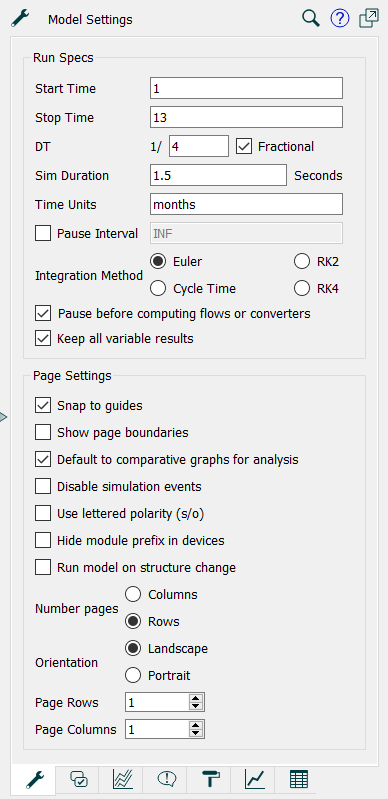Use the Model Settings Properties panel to set Run Specs and Page settings for the model.
To open the Model Settings, switch to Edit mode and click on an empty space in the model. (If you've closed the Properties panel, you'll need to double-click, or slide it out with the ![]() button appearing at the right of the application.)
button appearing at the right of the application.)

Use these boxes to specify the length of the simulation. The values you enter must be numerical.
The values you enter here depend on the Time Units you've chosen for the model. For example, if Time Units is set to Months and you want to run the simulation for a year (12 months), you'd specify 0 and 12 (or 1 and 13, if you prefer to report values Reporting values in tables) as the Start and Stop Time values. Or, if the unit of time is Years and you wanted to run the simulation from one specified year to another, you could type 1970 and 2010 as the Start and Stop Time values. If you wanted to run the simulation for 100 years, you could type 0 and 100 as the Start and Stop Time values.
The value in the "Stop Time" box has to be greater than the value in the "Start Time" box.
Note: If the value in the DT box is greater than 1 and isn't evenly divisible into the length of simulation specified by the Start and Stop Time values, Stella Professional chooses the closest multiple of DT for the simulation length.
This box specifies the Delta Time (simulation time step), either by specifying a value in the box, or by specifying DT as a fraction.
Regardless of the method you use, choose a DT small enough to let you capture the shortest time frame of interest in your model. The trade-off here is speed versus accuracy. The more calculations per unit of simulation time, the longer it takes to complete a given simulation. For more about DT, see Overview: DT.
Enter a preferred Time Unit for model simulations in the Time Unit box. The unit of time you enter is used for display purposes and to compute units of measure for flows.
Use this option to adjust the speed of the simulation by specifying how many seconds it should take to run the entire simulation.
By slowing the simulation down, you allow model users time to view changes in the model as a run unfolds. This is especially useful on the interface. Use 0 if you do not want to slow down the simulation.
Use this box to specify the length of time after which you want the model simulation to pause the run.
For example, if the Time Unit is Months and the length of the simulation is a year, but you want the simulation to pause every quarter, you would enter 3 as the pause interval.
To have the simulation run without pausing, clear the Pause Interval check box. The Pause Interval shows INF. This is the default setting for the pause interval.
When the Pause interval is set at a value less than the length of the simulation, the model simulation runs will pause like you've specified. You can then review values, change constants, and continue the simulation with the new values. If you're pausing the simulation for the purpose of changing values, checking Pause before computing flows or converters (below) is recommended.
Select the integration method that you want to use for the run:
For more information about these integration methods, see Understanding integration methods. For more information about Cycle-time calculations and how time-stamping works, see Cycle-Time Introduction.
Select this check box to have the simulation pause before flows and converters are computed. Whether the pause is from the Pause interval above or as a result of Defining Simulation Events, the simulation will pause after computing stocks. Then, any changes you make to constants by moving knobs or making an entry in the Results panel will take immediate effect. If you don't check this, there'll be a 1 DT delay before changes take effect.
Select this check box to keep results for all variables in the model. If this check box isn't selected, only model variables that are assigned to output devices (like graphs or tables) will be recorded. This option is highly recommended, except for very large models that run for a very long time and would consume too much memory.
If you select this check box, a small graph will appear inside each stock or flow when the simulation is run, and the results for each variable will be available on the Results panel.
